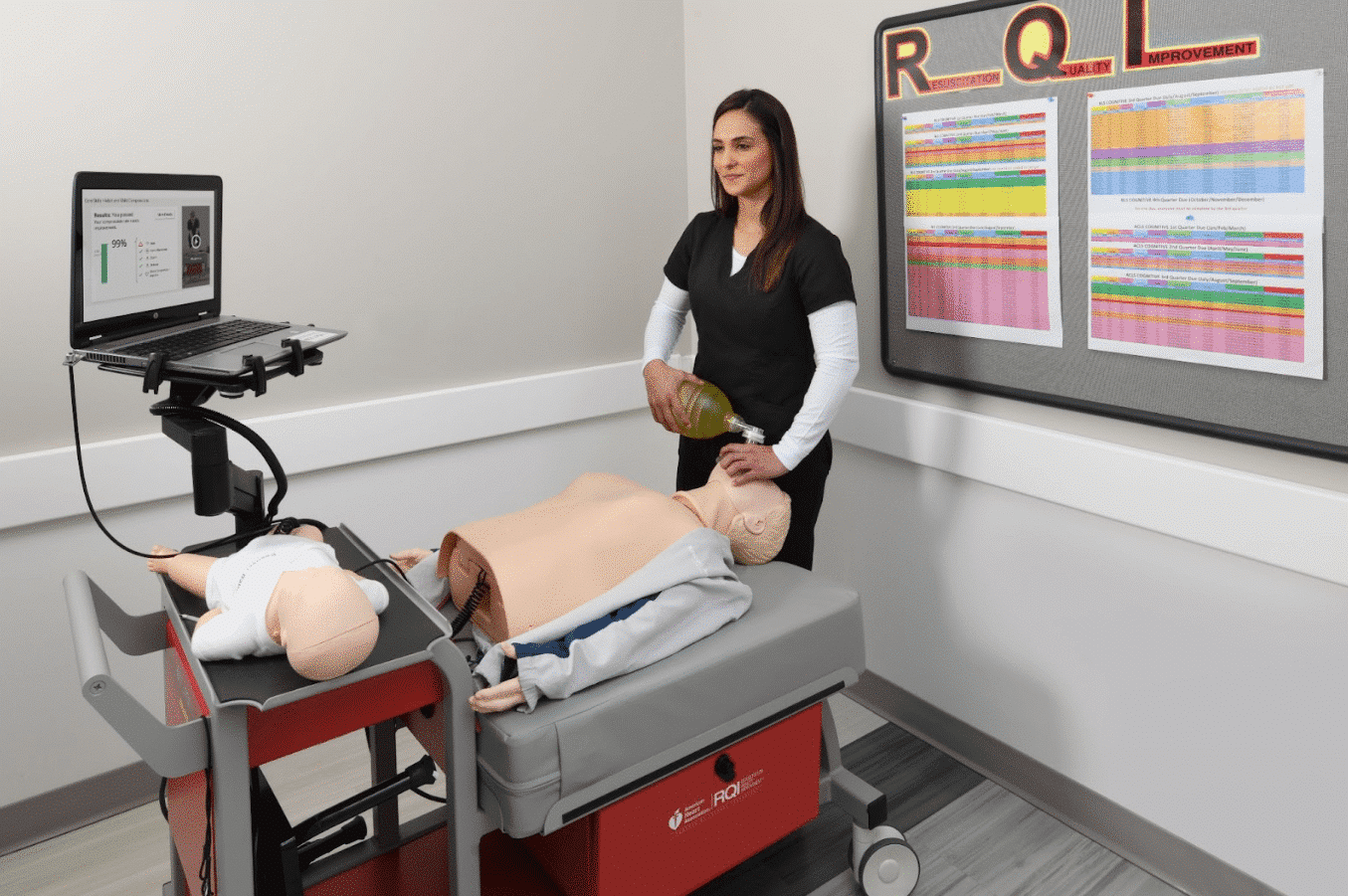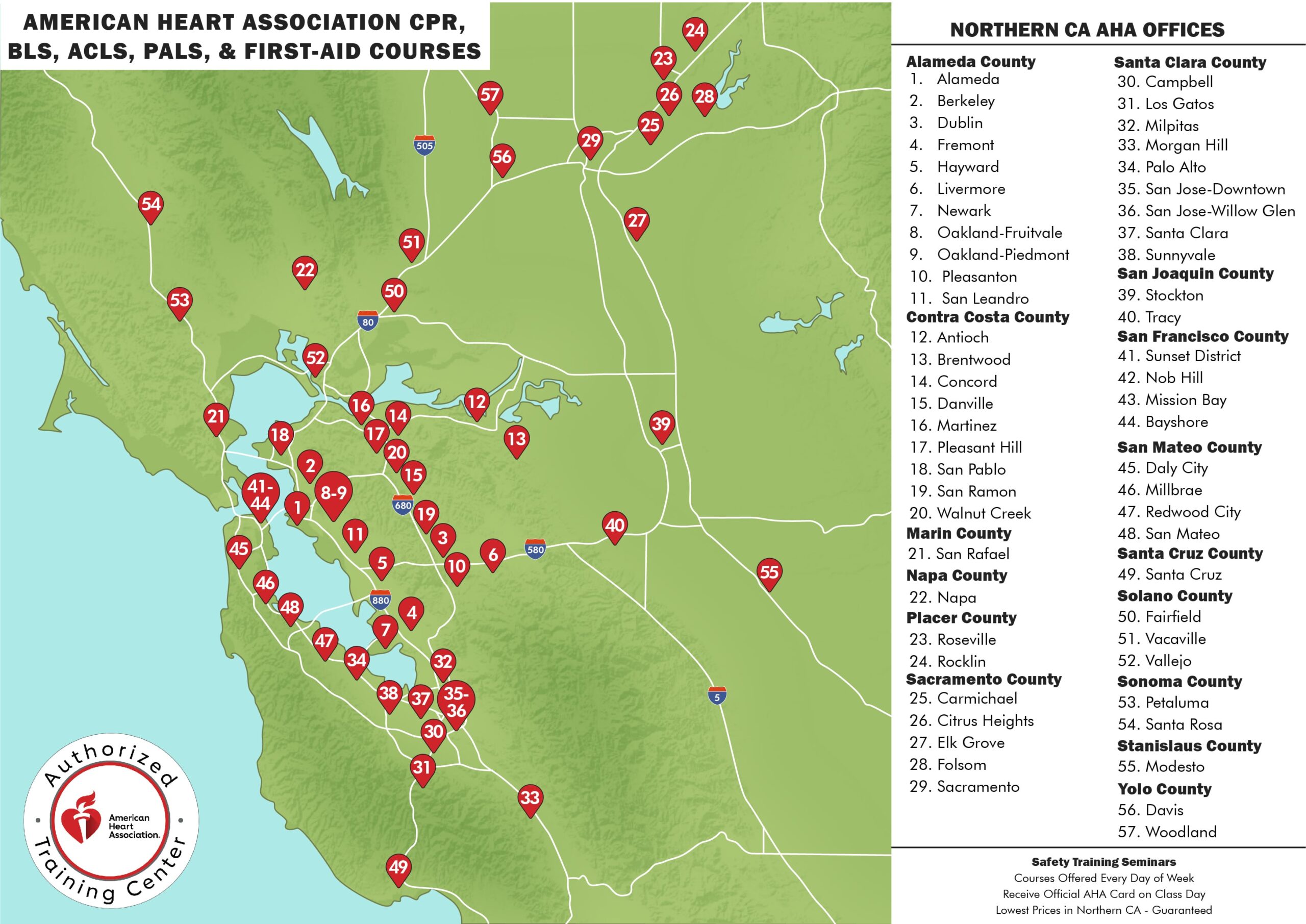
American Heart Association Course Registration
Safety Training Seminars offers American Heart Association CPR, BLS, ACLS, and PALS courses in Santa Cruz, CA. This office is close by the surrounding cities of Morgan Hill and Los Gatos. If you live in Santa Cruz, you can take a BLS, ACLS, or PALS course near you. We can teach CPR & First-aid classes at your location any day of the week. Ask us about our group discounts.
American Heart Association Course Registration
Safety Training Seminars offers American Heart Association CPR, BLS, ACLS, and PALS courses in Santa Cruz, CA. This office is close by the surrounding cities of Morgan Hill and Los Gatos. If you live in Santa Cruz, you can take a BLS, ACLS, or PALS course near you. We can teach CPR & First-aid classes at your location any day of the week. Ask us about our group discounts.
What is American Heart Association RQI
The American Heart Association RQI (Resuscitation Quality Improvement) program is one of the most popular, modern, and efficient ways for medical and healthcare professionals to receive their official American Heart Association BLS, ACLS, and PALS certification cards.
Three Easy Steps
1. Take the American Heart Association online course at home (a few hours).
2. Arrive to one of our 45 local offices and practice with the VAM (voice assisted manikin).
3. Receive your certification card on the day of the class.

About American Heart Association RQI
Entry Instructions for Santa Cruz CPR Classroom
Exploring Medical Facilities in Santa Cruz, CA: Providing Care and Wellness
Nestled on the scenic coastline of California, Santa Cruz is renowned for its stunning views, vibrant community, and a range of attractions that draw both residents and visitors alike. Beyond its natural beauty and cultural offerings, the city boasts a network of medical facilities that cater to the healthcare needs of its diverse population. From world-class hospitals to specialized clinics, Santa Cruz’s medical landscape reflects its commitment to providing quality care and promoting wellness.
Hospitals at the Heart of Care
At the forefront of medical care in Santa Cruz are its reputable hospitals. Dominican Hospital, a part of Dignity Health, stands as a pillar of healthcare excellence in the region. With advanced medical technology and a dedicated staff, Dominican Hospital offers comprehensive services, including emergency care, surgical interventions, and specialized treatments. Its compassionate approach to patient care resonates with the city’s community-focused spirit.
Adjacent to Dominican Hospital is the Santa Cruz County Health Services Agency, encompassing various healthcare programs that prioritize preventive and primary care. The agency’s offerings range from family planning services to infectious disease management, serving as a vital resource for residents in need of various medical interventions.
Specialized Care for Diverse Needs
Santa Cruz recognizes the importance of specialized care and offers numerous clinics catering to specific medical needs. For mental health services, the Santa Cruz Community Health Centers provide counseling, therapy, and support to promote mental well-being. These centers play a critical role in addressing the mental health challenges that many communities face.
The Women’s Health Center specializes in providing comprehensive care tailored to the unique needs of women. From reproductive health to menopause management, the center offers a holistic approach that places emphasis on patient education and empowerment.
Innovation in Medical Care
The medical landscape of Santa Cruz also embraces innovation. The Palo Alto Medical Foundation (PAMF), part of the Sutter Health network, operates in Santa Cruz, offering a range of services that blend technological advancements with patient-centric care. PAMF’s integration of electronic health records and telehealth services showcases the city’s commitment to embracing the future of healthcare.
Fostering Wellness and Prevention
Santa Cruz’s medical facilities extend their reach beyond treating illnesses. The city places a strong emphasis on wellness and prevention. The Santa Cruz Integrative Medicine and Primary Care Clinic exemplifies this approach by focusing on a whole-person approach to healthcare. Combining conventional medicine with holistic practices, the clinic supports patients in their journey to achieve overall well-being.
Furthermore, the city’s commitment to holistic health is evident through its yoga studios, fitness centers, and community wellness events. These initiatives align with the belief that a healthy lifestyle is a cornerstone of preventing various health issues.
A Collaborative Healthcare Ecosystem
What makes Santa Cruz’s medical landscape truly impactful is its collaborative approach to healthcare. Medical facilities often collaborate with community organizations, local schools, and advocacy groups to address health disparities and provide educational resources. The city’s commitment to working together to improve health outcomes is a testament to its strong sense of community.
In conclusion, Santa Cruz, CA, stands as a city that not only showcases natural beauty but also prioritizes the health and well-being of its residents. With a network of hospitals, clinics, and specialized facilities, the city provides a comprehensive range of medical services. From cutting-edge technology to holistic approaches, Santa Cruz’s medical facilities embody the values of care, wellness, and collaboration that define the city’s essence.
Life-Saving Skills: Exploring CPR, BLS, ACLS, and PALS Classes
In the realm of emergency medical care, few skills are as crucial as Cardio-Pulmonary Resuscitation (CPR) and Advanced Cardiac Life Support (ACLS), Basic Life Support (BLS), and Pediatric Advanced Life Support (PALS) techniques. These life-saving techniques form the backbone of first response and medical intervention, often making the difference between life and death in critical situations. Let’s delve into the significance of each of these classes and their role in maintaining public health and safety.
Cardio-Pulmonary Resuscitation (CPR): CPR is a fundamental life-saving technique that can be administered by trained individuals to sustain blood circulation and provide artificial respiration when a person’s heart has stopped beating. CPR involves a combination of chest compressions and rescue breaths, aimed at keeping oxygenated blood flowing to vital organs until professional medical help arrives. CPR classes provide participants with the skills to recognize cardiac arrest, perform effective chest compressions, and deliver rescue breaths. These classes are vital for both medical professionals and laypersons, empowering them to respond swiftly and effectively in emergencies.
Basic Life Support (BLS): BLS takes CPR skills to the next level by incorporating additional techniques and equipment usage. BLS classes are designed for healthcare providers, including doctors, nurses, paramedics, and emergency medical technicians (EMTs). Participants learn how to assess a patient’s condition, deliver high-quality CPR, and use automated external defibrillators (AEDs) to restore a regular heartbeat. BLS training emphasizes teamwork, effective communication, and quick decision-making to optimize patient outcomes during cardiac emergencies.
Advanced Cardiac Life Support (ACLS): ACLS is an advanced course tailored for healthcare professionals who are involved in the management of cardiac arrest and other cardiovascular emergencies. ACLS builds upon the foundation of BLS and focuses on identifying and treating potentially life-threatening conditions such as stroke, myocardial infarction, and arrhythmias. Participants learn to interpret electrocardiograms (ECGs), administer medications, and perform advanced airway management. ACLS classes equip medical personnel with the skills to respond confidently to complex cardiac scenarios, ensuring comprehensive care for critically ill patients.
Pediatric Advanced Life Support (PALS): PALS training is geared towards healthcare providers who care for infants and children during emergencies. Pediatric patients have unique physiological needs, making PALS classes essential for those working in pediatrics, emergency medicine, and intensive care. PALS courses cover topics such as pediatric assessment, effective respiratory support, and the management of pediatric cardiac arrest. Participants gain the knowledge and skills necessary to provide specialized care and interventions that can make a critical difference in the outcomes of pediatric emergencies.
NRP, or Neonatal Resuscitation Program, is a critical medical initiative that focuses on saving newborns who struggle to breathe at birth. This specialized training equips healthcare providers with the skills to assess and manage respiratory distress in infants. NRP emphasizes a systematic approach, teaching effective ventilation techniques and chest compressions if needed. Regularly updated guidelines ensure that participants stay current with the best practices in neonatal care. By enhancing healthcare professionals’ abilities to respond swiftly and effectively to newborn respiratory challenges, NRP plays a vital role in improving infant survival rates and ensuring a healthier start to life.
First-aid classes offer indispensable life skills that empower individuals to respond confidently in emergencies. These structured courses cover a spectrum of situations, from minor injuries to critical incidents, teaching participants how to provide immediate care before professional help arrives. Participants learn to administer CPR, treat wounds, manage choking, and address common health crises. Hands-on training fosters essential skills and boosts confidence, enabling swift and effective action in times of need. First-aid classes are invaluable for workplaces, homes, and communities, creating a network of capable first responders. Mastering these skills not only saves lives but also fosters a safer and more prepared society.
Incorporating these life-saving techniques into healthcare systems, workplaces, and communities can significantly enhance the response to medical emergencies. Quick and effective interventions provided by individuals trained in CPR, BLS, ACLS, and PALS can stabilize patients and improve their chances of survival before professional medical assistance arrives. Moreover, these classes promote a culture of preparedness, empowering individuals to step forward and take action when faced with emergency situations.
In conclusion, American Heart Association CPR, BLS, ACLS, and PALS classes play an indispensable role in equipping individuals with the skills and knowledge needed to respond effectively to various medical emergencies. These courses bridge the gap between bystander assistance and professional medical care, ultimately contributing to improved patient outcomes and increased survival rates. By investing in these life-saving classes, individuals and healthcare professionals alike become vital links in the chain of survival, ensuring that timely and appropriate care is delivered when it matters most.
Our Blog

Why CPR is Important in Healthcare
Cardio-pulmonary resuscitation (CPR) is a life-saving technique that everyone should know how to perform. It involves a series of actions designed to help someone who has stopped breathing or whose

7 Common CPR Myths Debunked
Cardiopulmonary resuscitation (CPR) is a life-saving technique that can help a person in the event of cardiac arrest. It involves chest compressions that are performed until medical professionals arrive or

Importance of Workplace CPR & First-Aid Training
Accidents can happen anytime and anywhere, even in the workplace. Although we may try our best to ensure a safe and healthy work environment, we can’t predict or prevent all



